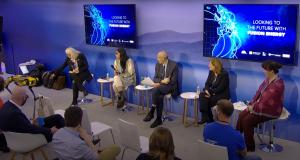Fusion and climate change: a conversation begins
For the past six years, beginning with the famous COP21 in Paris, ITER and the global fusion community have fought for a seat at the table in climate change discussions. Year after year, the best-laid plans have been rejected. The ITER Organization has gained accreditation—entitling its director-general to a 3-minute speech in the plenary session—but no more than that. This year, for COP26 in Glasgow, it was the same story: all fusion proposals were rejected. Until, at the last minute, someone intervened.
Rumour has it that Prime Minister Boris Johnson himself was the one who stepped in, insisting on a place for fusion on the program. Certainly that would be commensurate with the UK government's recent fusion advocacy; in recent years, the United Kingdom has committed more than £200 million toward accelerating the arrival of fusion electricity generation, in addition to its contributions to the ITER project, and as the host of JET (Joint European Torus).
Whoever the intercessor, ITER and its co-host, the UKAEA (United Kingdom Atomic Energy Authority) were determined to maximize the opportunity: a 60-minute panel in the diplomatic Blue Zone on "Looking to the Future with Fusion Energy" on the final day of COP26.
The panel lived up to its ambitions, delivering a conversation that was animated and hopeful. It opened by defining fusion's relevance to COP26 and its goal of a green energy future: as Aneeqa Khan put it, "[Fusion] has the capacity to provide a stable baseload when it's not windy, when it's not sunny. At the moment, that role is being taken by fossil fuels, and we need to stop that." Panelists went on to reflect on remaining technological, regulatory, and communication challenges; the value of private-public partnership and international collaboration—including the increasing contributions of developing countries; and the importance of education both for citizens and for the coming generation of fusion leaders.
Perhaps the most telling outcome of the session is that, despite the diverse make-up of the panel, there was no argument regarding the varying projected timelines for commercializing fusion. The target, rather, was on how to collaborate to address remaining obstacles more efficiently. Even when an audience member asked how rapidly fusion could be commercialized "if governments were to treat the climate emergency in a similar way to how they treated the pandemic," the panel kept the spotlight on joint innovation—from manufacturing to education—to achieve the promise of fusion "soon enough to make a difference."
As Jane Hotchkiss of Energy for the Common Good put it, the event itself was a milestone. "We are, right now, witnessing fusion energy's involvement in the climate discussion, and until now that's never happened."
Follow this link to watch the panel discussion as it unfolded.


